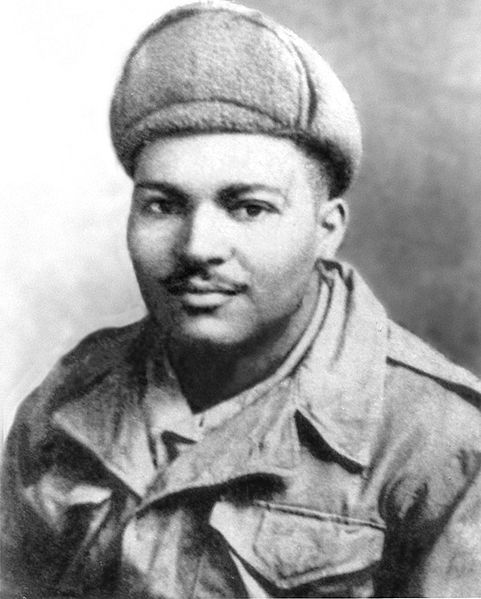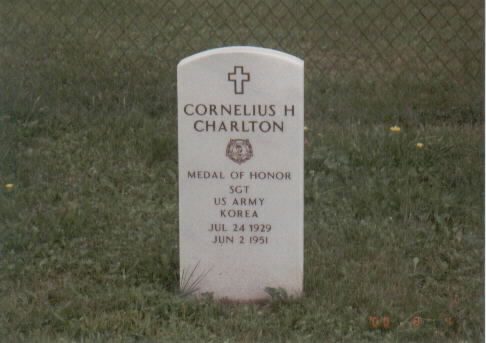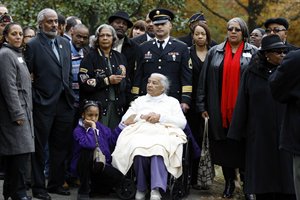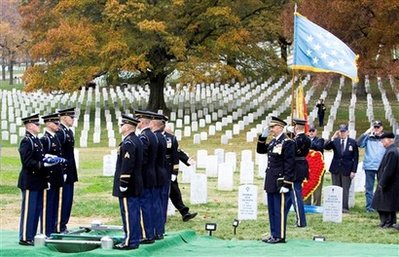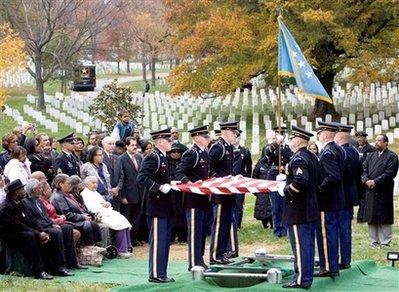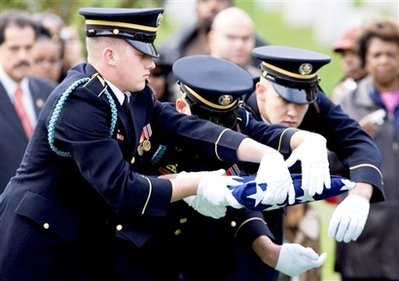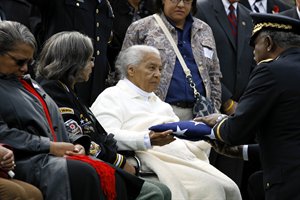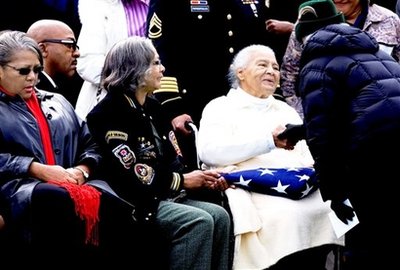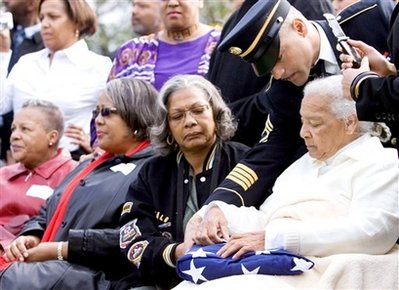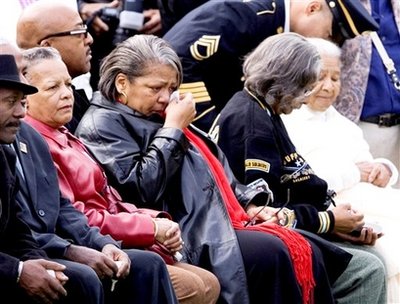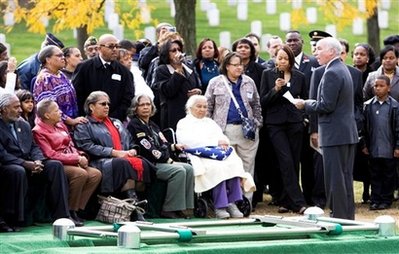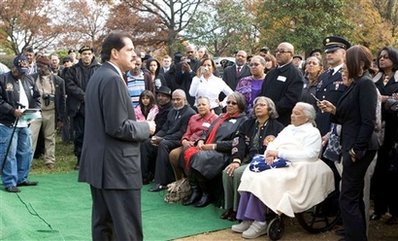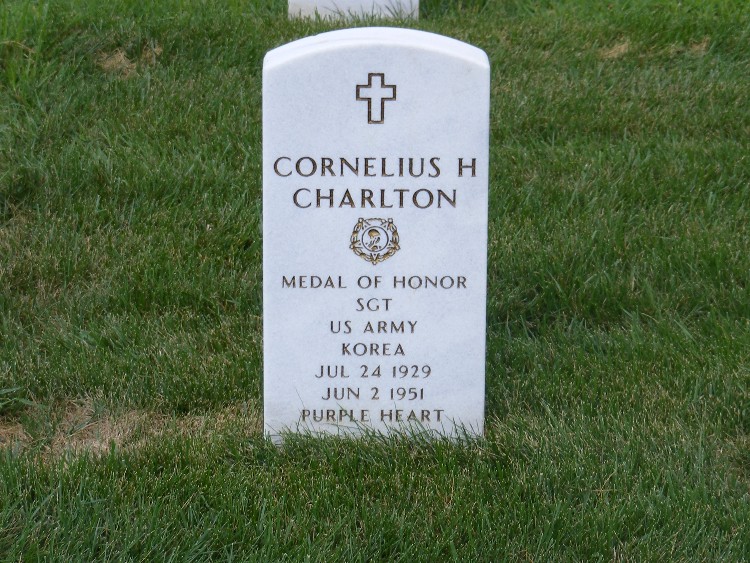CHARLTON, CORNELIUS H.
Rank and organization: Sergeant, U.S. Army, Company C, 24th Infantry Regiment, 25th Infantry Division.
Place and date: Near Chipo-ri, Korea, 2 June 1951.
Entered service at: Bronx, New York
Born: 24 July 1929, East Gulf, West Virginia
G.O. No.: 30, 19 March 1952.
Citation
Sergeant Charlton, a member of Company C, distinguished himself by conspicuous gallantry and intrepidity above and beyond the call of duty in action against the enemy.
His platoon was attacking heavily defended hostile positions on commanding ground when the leader was wounded and evacuated. Sergeant Charlton assumed command, rallied the men, and spearheaded the assault against the hill.
Personally eliminating 2 hostile positions and killing 6 of the enemy with his rifle fire and grenades, he continued up the slope until the unit suffered heavy casualties and became pinned down.
Regrouping the men he led them forward only to be again hurled back by a shower of grenades. Despite a severe chest wound, Sergeant Charlton refused medical attention and led a third daring charge which carried to the crest of the ridge. Observing that the remaining emplacement which had retarded the advance was situated on the reverse slope, he charged it alone, was again hit by a grenade but raked the position with a devastating fire which eliminated it and routed the defenders.
The wounds received during his daring exploits resulted in his death but his indomitable courage, superb leadership, and gallant self-sacrifice reflect the highest credit upon himself the infantry, and the military service.
Cornelius H. Charlton (July 24, 1929–June 2, 1951) was a United States Army soldier and a posthumous recipient of America’s highest military decoration—the Medal of Honor—for his actions in the Korean War.
Cornelius Charlton was born in West Virginia to Van and Clara (née Thompson) Charlton. In 1944, the family moved from West Virginia to the Bronx in New York City. Cornelius attended James Monroe High School there and, after graduating, enlisted in the U.S. Army in 1946. Charlton, an African American, was entering a segregated military. In 1948, President Harry S. Truman ordered the desegregation of U.S. forces, but it would take until 1951 before all units were integrated.
A career soldier, Charlton served with the U.S. troops occupying Germany in the aftermath of World War II before being sent to Korea. Initially assigned to an engineering group, Charlton requested transfer to an infantry unit and was subsequently placed in Company C of the 24th Infantry Regiment, 25th Infantry Division. The U.S. Army was still in the midst of desegregation, and the 24th Infantry was the last all-black regiment in operation.
In May, 1951, Charlton’s unit pushed northwards with the Eighth Army. On June 2, near the village of Chipo-ri northeast of Seoul, his platoon encountered heavy resistance while attempting to take Hill 543. Taking command after his platoon leader was wounded, Charlton regrouped his men and led an assault against the hill. Wounded by a grenade, he refused medical attention and continued to lead the charge. He single-handedly attacked and disabled the last remaining enemy gun emplacement, suffering another grenade wound in the process. Sergeant Charlton succumbed to his wounds that day, dying at the age of 21. For his actions during the battle, he was awarded the Medal of Honor.
Charlton’s body was returned to the United States and buried in his mother’s family burial place, Pocahontas Cemetery in Pocahontas, Virginia. The cemetery eventually fell into disrepair, and Charlton was re-interred in the American Legion Cemetery in Beckley, West Virginia. In 2008, he was re-interred at Arlington National Cemetery.
Several structures have been named in Charlton’s honor, including a park in the Morrisania neighborhood of the Bronx, a ferry boat that traveled to Governors Island in the Upper New York Bay, a bridge on Interstate 77 in his home state of West Virginia, and, in 1993, an Army barracks complex in South Korea.
In 1958, trees were planted in Van Cortlandt Park in the Bronx in his honor.
In 1999 the U.S. Navy christened a cargo transport ship, USNS Charlton, named for Sergeant Charlton. His sister, Fairy M. Papadopoulos, served as the ship’s co-sponsor.
By MANNIX PORTERFIELD
Courtesy of The Register-Herald
24 October 2008
Cornelius Charlton’s long and painful odyssey that began on torturous Hill 543 in war-riddled Korea more than half a century ago and took him through burial grounds in the two Virginias is finally ending with long-denied honors at Arlington National Cemetery.
An Army sergeant, Charlton posthumously won a Purple Heart and the Medal of Honor for exceptional bravery in combat in what evolved into a one-man juggernaut on a blood-soaked knoll in Korea.
A native of East Gulf in Raleigh County, Charlton died June 2, 1952, after leading three charges up Hill 543 near Chipo-ri, taking control of his platoon after the commander suffered a disabling wound.
Charlton rallied his comrades and led a second charge, personally knocking out two enemy positions and killing half a dozen soldiers with a combination of grenades and rifle fire. Heavy casualties thrust the platoon back, but Charlton, although mortally wounded himself in the chest, spearheaded a third assault.
Another grenade found Charlton, but the gritty soldier charged the remaining position alone, living long enough to silence his tormentors.
In life, the ill-fated engagement on Hill 543 consumed little consumed little time, but it took Charlton, in death, decades to win his final battle — one of race, his brother asserted in a 1990 interview, that kept him immediately after death from receiving equality with America’s other fallen heroes.
Charlton served in a nearly forgotten era when the U.S. military remained partially segregated, and, as a black, he initially was barred from interment in Arlington, according to his brother, Arthur, and New York City’s Department of Parks & Recreation, which maintains a park in deference to his Bronx growing-up years and military heroism.
Arlington’s superintendent, John Metzler, however, discounted that race would have been used to deny Charlton or anyone else from being buried in the cemetery.
“We’ve never discriminated against anyone,” Metzler told The Register-Herald.
“If you have military service, we don’t ask what your race is. We have no need to know that. There is no evidence that would ever have happened. It was never a policy of the Army. He would not have been turned down because he was black … I have seen this story, too, and it has bothered me tremendously. We have people since the beginning of our history in 1864, people of color, who are buried here at the cemetery, and we have never discriminated against anyone.”
Since Arlington was not an option at the time, his family brought his remains back to the Bryant Memorial Cemetery in near Pocahontas, Virginia, a privately-owned cemetery that served African American families of the region.
Bryant Memorial did not have a perpetual care program in place and became overgrown with brush and was in that condition when Charlton’s grave was rediscovered and his remains were taken to the American Legion Cemetery in Beckley, not far from where he was born. A local volunteer group is currently working to clear the old Bryant Memorial Cemetery.
In a special November 12, 2008 ceremony, a niece, Zenobia Penn of New London, Connecticut, plans to join other family members and a Connecticut congressman, or a member of his staff, in a national honor for her heroic uncle.
“I’m extremely proud,” she said Thursday. “My family is as well. I’ve always felt like I had a personal connection to him and his spirit.”
A program coordinator for the Opportunities Industrialization Centers, Penn never knew her famous uncle.
“My mother was eight months pregnant with me when my uncle was killed,” she explained.
“There was not a time when my family didn’t get together on a regular basis that I didn’t grow up knowing my Uncle Connie and the story of him. I didn’t know him in the physical sense. But the thing is, the more you become familiar with someone, it doesn’t matter if it’s a relative or a character out of a book or anything to that degree, so long as the substance of that person is communicated to you on a constant basis, you get to know that person.
That has been a sense from the beginning of time I could put it all together.”
Penn drew even closer to the story of her uncle because of the park in the Bronx — Charlton Garden — that bears his name in a neighborhood known as Morrisania. The same year Charlton was wounded mortally in Korea, the city council passed an ordinance naming it the Sergeant Cornelius H. Charlton Playground. From there, it was officially renamed Charlton Playground, and ultimately Charlton Garden.
Veterans raised some $1.5 million to renovate the park and keep it in Charlton’s honor, in homage to the place he grew up after his birth in West Virginia, the niece said.
“He was a resident of that time of the Bronx when he went in to the Army,” Penn said. “He went to school in New York and then went into the Army from there.”
Penn worked with her family and the veterans involved with Charlton Garden to pursue the transfer of the uncle’s remains from Beckley to Arlington. The effort accelerated when she enlisted the help of Representative Joe Courtney, D-Connecticut, who plans to attend the ceremony next month at the national burial ground, according to his communications director, Brian Farber.
Charlton might have gone through the Korean Conflict as a virtual unknown at a routine desk job, where he originally was assigned, but he volunteered for combat duty and wound up with Co. C in the 24th Infantry Regiment of the Army’s 25th Infantry Division.
Once the Medal of Honor Society entered the picture, American Legion Post 32 in Beckley enlisted the aid of local writer-historian Pauline Haga to track down Charlton’s gravesite in Pocahontas, Virginia.
History buffs who often seek out the war dead and decorate their graves, Pauline and husband Leslie Haga Sr. embarked on the arduous task of finding Charlton’s grave among rows of stones.
“We made three trips to Pocahontas and found he was there in a cemetery that was so overgrown with briers you had to crawl through it,” she said.
“We had found him by researching through old records. My husband had to crawl along the bank of a wooded area. Hundreds of veterans are buried there. It’s a unique, old, historical cemetery.”
Once they confirmed Charlton’s grave and marked it with an American flag for easy spotting, the Hagas got in touch with Melton Mortuary of Beckley to have the remains disinterred and brought to the Beckley cemetery. Now, says Melton owner, Henry Melton, the firm will handle the transfer to Arlington.
Two original steel spans on the West Virginia Turnpike bear the names of Charlton and another native who distinguished himself in the military — pilot Chuck Yeager, who flew 64 combat missions in World War II. In deference to the kind of construction that went into the two spans, both are protected on the federal Register of Historic Places. The one honoring Charlton is in Mercer County.
There is talk of leaving something behind to remember Charlton in this area — the grave marker at the Legion cemetery.
“Rather than just dispose of it, since it’s been here a number of years, we’re considering leaving it and putting maybe a brass plate on the bottom of it, identifying who it represents and how long he was buried here and when he was removed to Arlington,” Post 32 commander Jim Rubin explained.
Penn endorsed the effort to retain some semblance of honor for her uncle at the Beckley cemetery, and expressed gratitude for the work of Post 32 and others in according Charlton honor he achieved on the field of combat.
“God bless you all,” she said.
Bronx vets get black Korean War hero proper burial at Arlington
By Patrice O’Shuaghnessy
Courtesy of the New York Daily News
Sunday, November 9th 2008
This week, he will finally get the rest of what was coming to him when the Army sergeant’s remains are buried in Arlington National Cemetery – ending a half century of mystery, bitter tears and a quest to ennoble the young hero.
Snapping a salute as Army soldiers fold the U.S. flag into a triangle and a chaplain prays over the grave will be a cluster of graying veterans from the Bronx who made it their mission to get a fellow black soldier into the hallowed ground he had long been denied.
“I know the sorrow my family carried in their hearts for decades,” said Zenobia Penn, Charlton’s niece. “My grandparents and my mother were bitter about the injustice.”
“Finally, after 56 years, he is where he should be,” Robert Gumbs, one of the veterans who’ll be at Arlington, said with tears in his eyes.
Charlton died nine days shy of his 22nd birthday, showing extraordinary heroism. Eight months later, in February 1952, his parents were given his posthumous Medal of Honor. The medal qualified him to be buried in Arlington, but he was not.
“The Army didn’t tell the family he was eligible. Was it administrative oversight or did race play a role?” Gumbs said. “For this particular family not to have been notified, it raises suspicions.”
Penn recited the family lore: “The story I grew up hearing was my grandparents were in a procession with my Uncle Connie’s coffin on a horse-drawn wagon, taking him to Arlington, when they were met by rednecks. They were treated harshly; they were terrified. It was 1952, and segregation was still strong in the South.”
Charlton was one of 17 children of a West Virginia coal miner who moved his family to the Bronx. He attended James Monroe High School, and enlisted in the Army in 1946 at 17.
In an October 1950 letter to his sister, he wrote, “At last I am getting what I have been waiting for [combat duty].” It was signed, “Love your bro, Cornelius.”
He was with the 24th Infantry Regiment, the “Buffalo Soldiers,” the last all-black unit.
On June 2, 1951, he took command when the platoon leader was wounded and led an assault on a hill near Chipo-ri. He killed six enemy soldiers before he suffered a chest wound. He refused medical aid and continued up the hill and was hit by another grenade. Before he died, he raked the enemy position with gunfire, eliminating it.
Charlton was buried in the family’s plot in East Gulf, West Virginia.
The military says no one has been barred from Arlington because of race, but as Charlton was lauded through the years, that became accepted truth.
Final honors: 57 years later, black GI buried at Arlington
Courtesy of Stars & Stripes
15 November 2008
Sergeant Cornelius Charlton was posthumously awarded the Medal of Honor for his service in the Korean War. It’s taken 57 years for him to be buried at Arlington National Cemetery in Virginia. He is the first black Medal of Honor decorated Korean War veteran buried at Arlington. More than 100 family, friends and veterans made the trip to honor Charlton.
Army Sergeant Cornelius Charlton was two months shy of his 22nd birthday when his platoon tried to take a hill near Chipo-Ri, South Korea. The platoon leader was wounded, so Charlton took command.
He rallied his men, who had suffered heavy casualties, and led the next assault, only to be pushed back again. Despite a severe chest wound, he refused medical attention and led another charge. He alone eliminated the remaining enemy emplacement, though he had been hit again by a grenade. His wounds led to his death on June 2, 1951.
The next year, Charlton was awarded the Medal of Honor, reserved for the “bravest of the brave,” and he was supposed to be buried at Arlington National Cemetery. But it didn’t happen. Until Wednesday.
No one knows exactly why it took 57 years for Charlton to receive his hero’s burial in the nation’s cemetery. But Wednesday, all that mattered was that more than 150 friends, relatives and others gathered for the long-awaited ceremony.
Charlton is the only black Medal of Honor recipient from the Korean War buried at Arlington; there are 15 other black Medal of Honor recipients buried there. Medal of Honor recipients automatically qualify for burial at Arlington.
“This was a historical moment, not only for the family but also for myself,” said Bob Gumbs, a veteran and one of the many people who worked to get Charlton buried at Arlington. “It’s really a culmination of a series of events. … It’s the culmination of a long effort.”
Charlton’s niece, Zenobia Penn, said she grew up hearing stories about her uncle “Connie,” the good guy, the nice guy. But the conversation would inevitably shift to “the injustice of him not being buried in Arlington Cemetery,” said Penn, 57, of New London, Connecticut.
According to family history, relatives had received Charlton’s medal and were in a caravan, on their way to Arlington Cemetery, with a horse-drawn buggy carrying the flag-covered coffin, Penn said.
“As they were approaching Arlington Cemetery, they were stopped by some folks in pickup trucks with shotguns, pointing at them and telling them he wasn’t going to be buried there,” Penn said. “They were just racists. They weren’t military. They weren’t Arlington representatives. They were just racists. They didn’t want to celebrate — it wasn’t time yet for the South to celebrate a black military hero.”
Penn’s grandparents buried Charlton in Pocahontas, Virginia, just across the border from West Virginia. In 1989, the Congressional Medal of Honor Society and the American Legion made arrangements for him to be buried at the American Legion cemetery in Beckley, West Virginia, where he remained until this week.
Charlton was honored in other ways. The Navy christened the USNS Charlton in 1999. There is a Charlton Memorial Bridge in West Virginia and a Charlton Gardens in New York.
Charlton Gardens is in the Bronx, where Charlton lived before enlisting. New York City named the property in his honor the year after he died. The city Department of Parks and Recreation Web site says Charlton “was barred from burial in Arlington National Cemetery because he was African-American.”
Arlington Superintendent John Metzler said credentials, not skin color, are what matter at Arlington. “We have always buried soldiers and race was never a question,” Metzler said.
Arlington historian Tom Sherlock said black servicemembers were buried at the cemetery within days of its opening on May 13, 1864. Members of what were then called the “United States Colored Troops” were buried in Section 27, right over the hill from Section 40, where Charlton was buried Wednesday.
The separate-sections policy ended after President Harry S. Truman desegregated the armed forces with Executive Order 9981 on July 25, 1948. Sherlock said he doesn’t doubt that the family might have encountered hostility on the way to the cemetery in the 1950s. But Wednesday’s burial was a “victory over whatever nonsense they heard,” he said. “This brave soldier is here in Arlington, where he belonged all along, and we’re honored to have his remains here.”
The family’s decision to resume the push for an Arlington burial stemmed from a racist incident Penn’s 6-year-old granddaughter suffered at school this year.
“I made a conscious decision to research Uncle Connie, to do the best I could and compile everything the best I could,” Penn said, “so she was aware of her history, of black history — to be proud of being a black female, despite the shade of her skin.”
Penn learned for the first time about the Bronx park named after her uncle. She discovered that a group of primarily black veterans had formed the Friends of Charlton Gardens and had raised $1.5 million to renovate the park and rededicated it in 2005. Penn contacted her congressman, Representative Joe Courtney, D-Connecticut, for help.
Ed Burke, Courtney’s military and veterans affairs field representative, said that he helped the family obtain certification that Charlton had been awarded the Medal of Honor and that Arlington accepted it. In September, the family was given the date when Charlton would be buried for the third and final time.
“It was bigger than anything I ever expected,” Penn said. “We only just wanted to right the wrong. “We had no idea this was going to keep going into something as monumental as this.”
Sergeant Cornelius H. Charlton’s sister Fairy Mae Papadopoulos, center in a wheelchair, and
her family during the reburial of Sergeant Charlton at Arlington National Cemetery on Wednesday Nov. 12, 2008
An Army honor guard stand at attention as the Medal of Honor flag is carried during a memorial ceremony for
Medal of Honor recipient Army Sergeant Cornelius Charlton, at Arlington National Cemetery Wednesday, Nov. 12, 2008
Honor Guard Soldiers Prepare To Fold The Flag Above The Remains
Of Medal of Honor Receipient Cornelius Carlton, November 12, 1008.
An Army honor guard passes a folded flag during a memorial ceremony for Medal of Honor recipient Army
Sergeant Cornelius Charlton, at Arlington National Cemetery Wednesday, November 12, 2008
Sergeant Cornelius Charlton’s sister Fairy Mae Papadopoulos receives flag from Chaplain (Lieutenant Colonel) Harry A. Rauch III
‘during the reburial of Sergeant Charlton at Arlington National Cemetery on Wednesday Nov. 12, 2008. By her side Papadopoulos’
daughters from left, Zenobia Penn and Cornelia Imbriglio
Fairy Mae Papadppoulos, second right, sister of Medal of Honor recipient Army Sergeant Cornelius Charlton, with nieces Cornelia Imbriglio, second left,
and Zenobia Penn, left, is greeted by Arlington Lady Pat Kirk, right, during a memorial ceremony for Sergeant Charlton, at Arlington
National Cemetery Wednesday, November 12, 2008
Fairy Mae Papadopoulos, right, sister of Medal of Honor recipient Army Sergeant Cornelius Charlton, with her son Army Sergeant First
Class Turham Papadopoulos, back right, niece Cornelia Imbriglio, look at the U.S. Flag presented to her during a memorial ceremony in
honor of Charlton, at Arlington National Cemetery Wednesday, Nov. 12, 2008
Zenobia Penn, center, niece of Medal of Honor recipient Army Sergeant Cornelius Charlton, wipes away tears during a memorial
ceremony for Sergeant Charlton, at Arlington National Cemetery Wednesday, November 12, 2008.
Representative Joe Courtney, D-Connecticut., right, delivers his remarks at a memorial ceremony in honor of
Medal of Honor recipient Army Sergeant Cornelius Charlton, at Arlington National Cemetery Wednesday, November 12, 2008.
CHARLTON, CORNELIUS H
- SGT US ARMY
- KOREA
- DATE OF BIRTH: 07/24/1929
- DATE OF DEATH: 06/02/1951
- BURIED AT: SECTION 40 SITE 300
ARLINGTON NATIONAL CEMETERY
Michael Robert Patterson was born in Arlington and is the son of a former officer of the US Army. So it was no wonder that sooner or later his interests drew him to American history and especially to American military history. Many of his articles can be found on renowned portals like the New York Times, Washingtonpost or Wikipedia.
Reviewed by: Michael Howard

